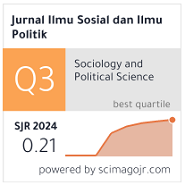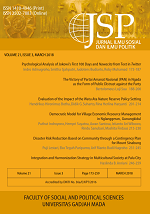Analysis of e-Government Services: A Study of the Adoption of Electronic Tax Filing in Indonesia
Rosdiana Sijabat(1*)
(1) Business Administration, Atma Jaya Catholic University of Indonesia
(*) Corresponding Author
Abstract
This study explores the impact of perceived usefulness, perceived ease-of-use, and perceived risks of using electronic tax filing (e-Filing) on the intention to use e-Filing through a technology acceptance model framework. The theoretical foundation used in this study is the technology acceptance model (TAM) on 201 valid questionnaires completed by Indonesian taxpayers. The data collected was analyzed by structural equation modelling using SmartPLS (3.0 Version). The results of the study revealed that e-Filing’s perceived usefulness and risk were significantly associated with intention to use, while perceived ease-of-use did not have a significant effect. Although the influence of perceived risks significantly mediated the influence of perceived usefulness, it did not significantly mediate the influence of ease-of-use. Gender was found to significantly moderate the influence of e-Filing’s perceived usefulness, but not to moderate the influence of perceived ease-of-use. Importance-Performance Matrix Analysis (IPMA) finds that the intention to use e-Filing is most strongly influenced by its perceived usefulness and perceived risk. This implies that policymakers must highlight the perceived usefulness and communicate the perceived risks of e-Filing to ensure taxpayers are willing to use the system. To the best of the author’s knowledge, this study is the first to examine both mediation and moderation to analyze the adoption of technology in Indonesia’s taxation system and offer a policy perspective through IPMA.
Keywords
Full Text:
PDFReferences
Anouze, A. L., & Alamro, A. S. (2019). Factors Affecting Intention to Use E-Banking in Jordan. International Journal of Bank Marketing, 1-27. doi:10.1108/IJBM-10-2018-0271
Bélanger, F., & Carter, L. (2012). Digitizing Government Interactions with Constituents: An Historical Review of E-Government Research in Information Systems. Journal of the Association for Information Systems, 13(5), 363-394. doi:10.17705/1jais.00295
Benitez, J., Henseler, J., Castillo, A., & Schuberth, F. (2020). How to Perform and Report an Impactful Analysis using Partial Least Squares: Guidelines for Confirmatory and Explanatory IS Research. Information & Management, 57(2), 1-16. Retrieved from https://doi.org/10.1016/j.im.2019.05.003
Bervell, B., & Umar, I. N. (2018). Utilization D ec is io n to ward s L M S fo r B lend ed Learning in Distance Education: Modeling The Effect of Personality Factors in Exclusivity. Knowledge Management & E-Learning: An International Journal, 10(3), 309-333. doi:10.34105/j.kmel.2018.10.018
Bhuasiri, W., Zo, H., Lee, H., & Ciganek, A. P. (2016). User Acceptance of e-Government Services: Examining an e-Tax Filing and Payment System in Thailand. Information Technology for Development, 22(4), 672-695. doi:10.1080/02681102.2016.1173001
Cam illeri, M . A . (2018). U nd ers tand ing the Impact of Acceptance of Digital Media for Stakeholder Engagement. An Experimental Analysis. Journal of Small Business and Enterprise Development, 26(4), 504-521. doi:10.1108/JSBED-02-2018-0042
Carmines, E. G., & Zeller, R. (1979). Reliability and Validity Assessment. Beverly Hills, CA: Sage Publications.
Cepeda-Carrion, G., Cegarra-Navarro, J.-G., & Cillo, V. (2019). Tips to Use Partial Least Squares Structural Equation Modelling (PLS-SEM) in Knowledge Management. Journal of Knowledge Management, 23(1), 67-89. doi:10.1108/JKM-05-2018-0322
Charag, A. H., Fazili, A. I., & Bashir, I. (2019).Determinants of Consumer’s Readiness to Adopt Islamic Banking in Kashmir. Journal of Islamic Marketing, 1-30. doi:10.1108/ JIMA-10-2018-0182
Chung, S.-H., & Yun, D. (2014). Revising Importance-Performance Analysis Combined with Regression Model: Applied to Seniors’ Travel Motivation and Performance Experiences. International Journal of Tourism Sciences, 14(2), 126-144. doi:10.1080/15980634.2014.11434694
Creswell, J. W. (2014). Research Design: Qualitative, Quantitative and Mixed Methods Approaches (4th ed.). Thousand Oaks, California: Sage.
Damghanian, H., Zarei, A., & Kojuri, M. A. (2016). Impact of Perceived Security on Trust, Perceived Risk, and Acceptance of Online Banking in Iran. Journal of Internet Commerce, 15(3), 214-238. doi:10.1080/15332861.2016.1191052
Davis, F. (1989). Perceived Usefulness, Perceived Ease of Use, and User Acceptance of Information Technology. MIS Quarterly, 13(3), 319-340. doi:10.2307/249008
Davis, F., Bagozzi, R., & Warshaw, P. (1989). User Acceptance of Computer Technology: A Comparison of Two Theoritical Models. Management Science, 35(8), 982-1003. doi:10.1287/mnsc.35.8.982
Deng, J., & Pierskalla, C. D. (2018). Linking Importance–Performance Analysis, Satisfaction, and Loyalty: A Study of Savannah, GA. Sustainability, 10(704), 1-17. doi:10.3390/su10030704
Dinu, A. M. (2012). Modern Methods of Risk Identification in Risk Management. International Journal of Academic Research in Economics and Management Sciences, 1(6), 67-71.
Dowling, G. R., & Staelin, R. (1994). A Model of Perceived Risk and Intended Risk- Handling Activity. Journal of Consumer Research, 21, 119-134. doi:10.1086/209386
Fornell, C., & Larcker, D. (1981). Evaluating Structural Equation Models with Unobservable Variables and Measurement Error. J. Market. Res , 18 (39), 39-50 . doi:10.2307/3151312
Gorondutse, A. H., & Hilman, H. (2016). Mediation Effect of the Organizational Culture on the Relationship between Perceived Ethics on Performance of SMEs. Journal of Industrial Engineering and Management, 9(2), 505-529. doi:10.3926/ jiem.1892
Gunzler, D., Chen, T., Wu, P., & Zhang, H. (2013). Introduction to Mediation Analysis with Structural Equation Modeling. Shanghai Arch Psychiatry, 25(6), 390–394. doi:10.3969/j.issn.1002-0829.2013.06.009
Hair, J. F., Hult, G. T., Ringle, C., & Sarstedt, M. (2017). A Primer on Partial Least Squares Structural Equation Modeling (PLS-SEM) (2nd ed.). Thousand Oaks, California: Sage.
Hair, J. F., Hult, G., Ringle, C., & Sarsted, M. (2014). A Primer on Partial Least Squares Structural Equations Modeling (PLS-SEM). Los Angeles: SAGE.
Hair, J. F., Ringle, C. M., & Sarstedt, M. (2011). PLS-SEM: Indeed a Silver Bullet. Journal of Marketing Theory and Practice , 19(2), 139- 152. doi:10.2753/MTP1069-6679190202
Hair, J. F., Ringle, C. M., & Sarstedt, M. (2019).The Use of Partial Least Square Path Modeling in International Marketing. Journal of Marketing Theory and Practice, 19(2), 277-320.
Hair, J. F., Risher, J. J., Sarstedt, M., & Ringle, C. M. (2019). When to Use and How to Report the Results of PLS-SEM. European Business Review, 31(1), 2-24. doi:10.1108/ EBR-11-2018-0203
Henseler, J. (2018). Partial Least Squares Path Modeling: Quo Vadis? Qual Quant, 52, 1-8. doi:10.1007/s11135-018-0689-6
Henseler, J., & Sarstedt, M. (2013). Goodness- of-fit indices for partial least squarespath modeling. Comput Stat, 23, 565–580. doi:10.1007/s00180-012-0317-1
Henseler, J., Ringle, C., & Sarsted, M. (2015). A New Criterion for Assessing Discriminant Validity in Variance-based Structural Equation Modeling. J. Acad. Mark. Sci, 43, 115–135. doi:10.1007/s11747-014-0403-8
Hubert, M., Blut, M., Brock, C., Zhang, R. W., Koch, V., & Riedl, R. (2019). The Influence of Acceptance and Adoption Drivers on Smart Home Usage. European Journal of Marketing, 53(6), 1073-1098. doi:10.1108/ EJM-12-2016-0794
Hussain, S., Fangwei, Z., Siddiqi, A. F., Ali, Z., & Shabbir, M. S. (2018). Structural Equation Model for Evaluating Factors Affecting Quality of Social Infrastructure Projects. Sustainability, 10(1415), 1-25. doi:10.3390/ su10051415
Kim, D., Ferrin, D., & Rao, H. (2009). Trust and Satisfaction, Two Stepping Stones for Successful E-Commerce Relationship: A Longitudinal Exploration. Information Systems Research (INFORMS), 20(2), 237-257. doi:10.1287/isre.1080.0188
Leon, S. (2018). Service Mobile A pps: A Millennial Generation Perspective. Industrial Management & Data Systems, 118(9), 1837-1860. doi:10.1108/IMDS-10-2017-0479
Machin, D., Campbell, M. J., Tan, S. B., & Tan, S. H. (2018). Sample Size for Clinical, Laboratory and Epidemiology Studies (4th ed.). Hoboken, New Jersey: John Wiley and Sons.
Merriman, M. (2015). What if The Next Big Disruptor Isn’t a What but a Who? Retrieved June 12, 2017, from ey.com : http://www.ey.com/Publication/vwLUAssets/EY-rise-of-gen-znew-challenge- forretailers/$FILE/EY-rise-of-gen-znew- challenge-for-retailers.pdf
Meule, A. (2019). Contemporary Understanding of Mediation Testing. Meta-Psychology, 3,1-7. doi:10.15626/MP.2018.870
Minta, N. K., & Stephen, O. (2017). Importance- Performance Matrix Analysis (IPMA) of Service Quality and Customer Satisfaction in t he G hanaian Bank ing Industry. International Journal of Academic Research in Business and Social Sciences, 7(7), 532-550. doi:10.6007/IJARBSS/v7-i7/3120
Mohajan, H. K. (2017). Two Criteria for Good Measurements in Research: Validity and Reliability. Annals of Spiru Haret University Economic Series, 17(3), 58-82. Retrieved from https://www.ceeol.com/search/ article-detail?id=673569
Mortimer, G., Hasan, S. F., Andrews, L., & Martin, J. (2016). Online Grocery Shopping: The Impact of Shopping Frequency on Perceived Risk. The International Review of Retail, Distribution and Consumer Research, 26(2), 202-223. doi:10.1080/09593969.2015.1130737
Nitzl, C., Roldan, J. L., & Ceped, G. (2016). Mediation analysis in partial least squares path modeling”, Industrial Management & Data Systems. Industrial Management & Data System, 116 (9), 1849-1864. doi:10.1108/IMDS-07-2015-0302
Obisesan, A. (2014, August 15). Gender Differences in Technology Adoption and Welfare Impact among Nigerian Farming Households. Retrieved August 12, 2018, from Munich Personal RePEc Archive: https://mpra.ub.uni-muenchen.de/58920/
Pantow, A. K., Sutrisno, & Saraswati, E. (2016). Taxpayer Behavior Analysis of Using E-Filing as a Tax Reporting System (Empirical Study in Malang City). Imperial Journal of nterdisciplinary Research, 2(4), 717-721.
Pengnate, S., & Sarathy, R. (2017). An E xperim ental Inv es tigation of T he Influence of Website Emotional Design Features on Trust in Unfamiliar Online. Computers in Human Behavior, 67(C), 49-60. doi:10.1016/i.chb.2016.10.018
PWC. (2018). PWC Survey: Digital Banking in Indonesia 2018. Retrieved July 20, 2019, from https://www.pwc.com/id/en/publications/assets/financialservices/digital-banking-survey-2018-pwcid.pdf
Ramayah, T., Cheah, J., Chuah, F., Ting, H., & Memon, M. A. (2018). Partial Least Squares Structural Equation Modelling (PLS-SEM) Using SMARTPLS 3.0: An Update and Practical Guide to Statistical Analysis (2nd ed.). Malaysia: Pearson.
Rana, N. P., Dwivedi, Y. K., Lal, B., Williams, M. D., & Clement, M. (2017). Citizens’ adoption of an electronic government system: tow ards a unified view. Information Systems Frontiers, 19(3), 549–568. doi:10.1007/s10796-015-9613-y
Ringle, C. M., & Sarstedt, M. (2016). Gain More Insight from Your PLS-SEM Results: The Importance-Performance Map Analysis. Industrial Management & Data Systems,116(9), 1865-1886. doi:10.1108/IMDS-10-2015-0449
Ritchey, F. (2008). The Statistical Imagination: Elementary Statistics for the Social Sciences (2 ed.). New York, USA: McGrawHill.
Ryu, Y., Kim, S., & Kim, S. (2018). Does Trust Matter? Analyzing The Impact of Trust on The Perceived Risk and Acceptance of Nuclear Power Energy. Sustainability,10(758), 1-17. doi:10.3390/su10030758
Schaupp, L. C., Carter, L., & McBride, M.E. (2010). E-file Adoption: A study of U.S. Taxpayers’ Iintentions. Computersin Human Behavior, 26(4), 636-644.doi:10.1016/j.chb.2009.12.017
Sekaran, U., & Bougie, R. (2017). Research Method for Business: A Skill-Building Approach (7 ed.). United Kingdom: John Wiley & Sons Ltd.
Singh, S., & Srivastava, R. (2018). Predicting The Intention to Use Mobile Banking in India. International Journal of Bank Marketing, 36(2), 357-378. doi:10.1108/IJBM-12-2016-0186
Slovic, P., & Peters, E. (2006). Risk Perception and Affect. Current Directions Psychological Science, 15, 322-325. doi:10.1111/j.1467-8721.2006.00461.x
Tanellari, E., Kostandini, Wabbi, G., Bonabana,Jackline, & Murray, A. (2014). Gender Impacts on Adoption of New Technologies: T he Case of Im prov ed Groundnut Varieties in Uganda. African Journal of Agriculture and Resource Economics, 9(4), 300-308. doi:10.22004/ag.econ.197017
Theriault, V., Smale, M., & Haider, H. (2017).How Does Gender Affect Sustainable Intensification of Cereal Production in The West African Sahel? Evidence from Burkina Faso. World Development, 92, 177-191. doi:10.1016/j.worlddev.2016.12.003
Venkatesh, V., & Morris, M. G. (2000, March). Why Don’t Men Ever Stop to Ask for Directions? Gender, Social Influence, and Their Role in Technology Acceptance and Usage Behavior. MIS Quarterly, 24(1), 115-139. doi:10.2307/3250981
Venkatesh, V., Morris, M., Davis, G., & Davis, F. (2003). User Acceptance of Information Technology: Towards a Unified View. MIS Quaterly Management Information System, 27(3), 425-478. doi:10.2307/30036540
Widiyanesti, S., & Reynaldi, M. R. (2017). Analisis Minta Penggunaan Layanan E-Filing oleh Wajib Pajak melalui Pendekatan Technology Acceptance Model (TAM) di KPP Pratama Purwakarta. Jurnal Manajemen Indonesia, 16(1), 63-70. doi:10.25124/jmi.v16i1.730
Wong, K. K.-K. (2016). Technical Note: M ed iatio n A nalys is , Categoric al Moderation Analysis, and Higher-order Constructs Modeling in Partial Least Squares Structural Equation Modeling (PLS -SEM): AB2B Example Using SmartPLS. The Marketing Bulletin, 26, 1-23. doi:10.13140/RG.2.1.1643.0562
Yoon, W., Ro, Y. S., & Cho, S.-i. (2019). Mediation Analysis of the Effect of Practical Training on the Relationship between Demographic Factors, and Bystanders’ Self-efficacy in CPR Performance. PLoS ONE, 14(4), 1-14. doi:10.1371/journal.pone.0215432
Zahid, H., & Din, B. H. (2019). Determinants of Intention to Adopt E-Government Services in Pakistan: An Imperative for Sustainable Development. Resources,8(128), 1-25. doi:10.3390/resources8030128
Zaidi, S. K., Henderson, C. D., & Gupta, G. (2017). The Moderating Effect of Culture on E-filing Taxes: Evidence from India. Journal of Accounting in Emerging Economies, 7(1), 134-152. doi:10.1108/ JAEE-05-2015-0038
Article Metrics
Refbacks
- There are currently no refbacks.
Copyright (c) 2020 Jurnal Ilmu Sosial dan Ilmu Politik

This work is licensed under a Creative Commons Attribution-NonCommercial-NoDerivatives 4.0 International License.






















